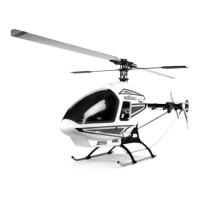As mentioned previously, JR 120° three Servo CCPM relies on the radio’s special CCPM Swashplate Mixing, rather than a
conventional mechanical mixer that is utilized to achieve the same results.
The radio’s 120° 3-Servo CCPM function automatically mixes the three servos to provide the correct mixing inputs for Aileron (roll),
Elevator (pitch) and Collective. The following is an example of how each control input affects the servo’s movement:
1. Collective
When a collective pitch input is given, all three servos (A, B, and C) move together in the same direction, at equal amounts, to raise
and lower the swashplate while keeping the swashplate level. During this function, all three servos travel at the same value (100%) so
that the swashplate can remain level during the increase and decrease in pitch. As mentioned, this mixing of the three servos is achieved
through the radio’s CCPM program.
2. Elevator (pitch)
When an elevator input is given, all three servos must move to tilt the swashplate
fore and aft, but their directions vary. The two rear servos (B and C) move together in
the same direction, while the front servo (A) moves in the opposite direction. For
example, when an up elevator (back cyclic) command is given, the two rear servos (B
and C) will move downward, while the front servo (A) moves upward so that the
swashplate will tilt aft. During this function, the front servo (A) travels at 100%, while
the two rear servos (B and C) travel at 50% (1/2 the travel value) of the front servo.
This difference in travel is necessary due to the fact that the position of the front
control ball is two times the distance of the two rear control ball position as measured
from the center of the swashplate. As mentioned, this mixing of the three servos is
also achieved through the radio’s CCPM program.
3. Aileron (roll)
When an aileron (roll) input is given, the two rear servos (B and C) travel in opposite directions, while the front servo (A) remains
motionless. For example, when a left aileron (roll) command is given, the left rear servo (C) will move downward, while the right rear
servo (B) will move upward to tilt the swashplate to the left. As mentioned, the front servo (A) will remain motionless. The travel value
for each of the two rear servos is 100%.
Please refer to the diagram at right for clarification.
36
HOW JR 120 CCPM WORKS
Front of Helicopter
Elevator Axis
JR 120° CCPM Control System
RADIO SYSTEM REQUIREMENTS (NOT INCLUDED):
6-channel or greater R/C helicopter system with 120° CCPM function (see list below), 5 servos, 1000 mAh receiver battery and gyro.
CCPM-Ready JR Radio Systems
Most current JR Heli radio systems (XP652,
XP8103 w/digital trims, 10X, as well as older 10
series systems) are equipped with 120° CCPM
electronics for use with the Ergo CCPM
machines. Radios you may be flying now, like
the X347, X388S, XP783, and XP8103* have
CCPM capability built in, but require activation
by the
Horizon Service Department.
Please call (217) 355-9511 for details.
*Please note that many XP8103 systems have the CCPM
function already activated. Please check with the Horizon
Service Center.
CURRENT RADIO SYSTEMS
JRP1656** PCM 10X, 5-8231 Servos (50/53/72 MHz)
JRP165TX PCM 10X, Transmitter Only (50/53/72 MHz)
JRP8622** XP8103FM, 5-517 Servos (50/53/72 MHz)
JRP8653** XP8103PCM, 5-531 Servos (50/53/72 MHz)
JRP6622** XP652 FM, 5-517 Servos (50/53/72 MHz)
XP652
10X
XP8103 DT

